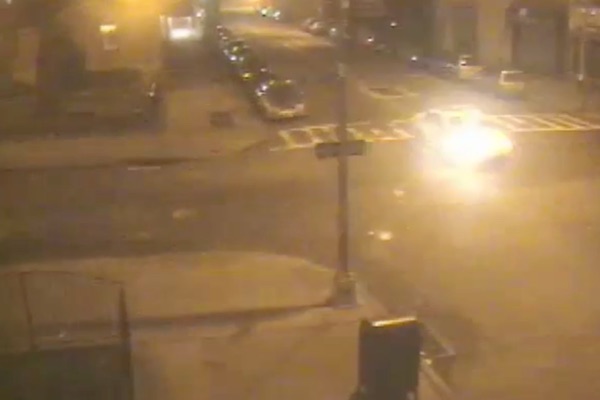After Death of Ryo Oyamada, NYPD Shows No Interest in Preventing Serious Police Crashes
2:55 PM EDT on June 2, 2017

Ryo Oyamada and friends in NYC. Photo via Gothamist
Relatives of Ryo Oyamada, killed by an NYPD officer while walking in Queens, have settled their lawsuit with the city. But NYPD did not acknowledge responsibility for Oyamada's death, and rejected the family's entreaties for measures to prevent deadly police crashes in the future.
Oyamada, a 24-year-old student and musician from Japan, was struck as he crossed 40th Avenue near his Queensbridge home at around 12:45 a.m. on February 21, 2013, by an NYPD patrol car driven by Officer Darren Ilardi. In the passenger seat of the cruiser was Officer Jason Carman.
In the wake of the crash, NYPD claimed Ilardi was traveling at 35 to 39 miles per hour, with roof lights activated, as the officers responded to a 911 call, and that Oyamada stepped in front of the cruiser mid-block. According to Ilardi's own testimony, a reconstruction report commissioned by the family's legal team, and other evidence, none of that was true.
The crash reconstruction report [PDF] says video showed Oyamada walking at a normal speed and with a normal gait before he started to cross 40th Avenue, to the east of 10th Street. The report says Ilardi, traveling eastbound, was driving at least 64 mph, covering the distance between Oyamada and the cruiser in half the time it would have taken had he adhered to the then-30 mph speed limit.
Ilardi was driving down the center of 40th Avenue -- a two-lane neighborhood street next to Queensbridge Houses -- rather than in the right lane, according to the report. The report indicates that the vehicle's speed and position in the street essentially trapped Oyamada in Ilardi's path. Evidence reviewed for the report suggests Ilardi applied the brakes before the collision, striking Oyamada in the westbound lane at 31 mph before steering toward the eastbound lane after impact. Oyamada died at the scene.
"His head was busted real bad," a witness told WABC. "His legs was twisted. Everybody was saying, you know, that was it for him. He was still breathing a little. He was taking deep breaths, trying to hold on."
Police were "making everyone back up toward the sidewalk," the witness said, but did nothing to aid or comfort the victim. "They just left him lying in the street. They wasn't trying to help him or anything. It's sad. Real sad."
Mid-block crossings are allowed on 40th Avenue, which is not bounded by signalized intersections on the segment where Oyamada was hit. Yet NYPD only told the press he was “out of the crosswalk,” failing to note Oyamada was crossing the street legally.
In testimony to the state Department of Motor Vehicles, Ilardi admitted what witnesses and video evidence indicated: the roof lights of the patrol car were not flashing when he hit Oyamada. "I cut the lights off," Ilardi said, according to Gothamist. "The next thing I know there's somebody in front of my car, I tried to swerve out of the way, and I struck the pedestrian."
The DMV did not suspend or revoke Ilardi’s drivers license, calling the collision “unavoidable,” Gothamist reported.

The lawsuit filed by Oyamada's family alleged that NYPD ordered witnesses away from the crash scene and discarded video evidence. (Vaccaro and White, the firm representing the family, says surveillance videos provided by the city “were edited to exclude images of the crash or its aftermath.”) The suit claimed the department didn’t check to see if Ilardi was using his cell phone at the time of the crash, and failed to do anything about Ilardi's poor driving record. Oyamada’s family also said radio transcripts and other evidence showed Ilardi was not responding to an assault, as NYPD initially claimed.
Monetary damages aside, Oyamada's family wanted NYPD to implement rules concerning when officers may turn off roof lights, attorney Steve Vaccaro told Streetsblog. The family wanted speed humps installed where Oyamada was struck. They sought a full public accounting of the crash. NYPD and the city conceded to none of those demands.
Said Vaccaro in a statement: “I was deeply disappointed that the city denied all of the non-economic relief requested by the Oyamada family -- measures aimed at accountability for the officers involved, preventing a re-occurrence, or simply allowing the public to know the full truth of what happened the night Ryo Oyamada was killed.”
On-duty NYPD personnel are involved in around 3,900 collisions a year, far more than staff of other city agencies, according to data obtained through a Streetsblog freedom of information request. Data on the severity of NYPD collisions is not published by the department or the city. However, yearly reports from the city comptroller’s office consistently show that NYPD leads city agencies in legal settlements, some of which result from vehicle crashes.
Ryo Oyamada was one of several bystanders killed in recent years in crashes involving NYPD drivers. Preventing further loss of life is apparently not a priority for NYPD or City Hall.
Oyamada's parents and sisters released a statement this week. Here it is in full:
On February 21, 2013, our youngest family member Ryo Oyamada was struck and killed by a speeding NYPD patrol car next to Queensbridge Houses, when he was just 24 years old.
Ryo was a son, brother, and friend who was loving and was loved. If he had not been unjustly killed, he would also have been an uncle.
For over four years, our family has struggled through language barriers and distance to try to learn the truth of what happened to Ryo and to hold the NYPD accountable for killing him. We live in Germany and Japan, and have made countless trips to New York City to identify Ryo’s mangled body, attend court conferences and a DMV hearing to find out the truth of what happened to Ryo and demand justice.
When Ryo was killed, we flew immediately to New York City. When we met Ryo's body, our mother asked ‘How was Ryo killed with such gruesome damage to his body by a speeding police car in a residential area?’ It didn’t make any sense then, and after over four years, it still doesn’t make sense. The NYPD officers in the patrol car were not responding to an assault in progress and had not activated their emergency lights, even though the NYPD claimed the opposite in its initial accounts. Findings of forensic expert Peter Chen demonstrate Ryo was killed in a preventable crash (redacted copy attached).
There is and has been a lack of political will to hold the NYPD accountable for killing Ryo. Our family feels that there is no way to hold the NYPD accountable through the court system.
After over four years, we have decided with heavy hearts to accept a settlement of our lawsuit against the city for his death.
This is not justice, and Officer Darren Ilardi should be held accountable for killing Ryo, as he sped recklessly next to public housing where children, families and pedestrians are always walking.
As the city continues a Vision Zero plan to reduce preventable traffic deaths, it is unfortunately exempting NYPD officers from following the rules and being held accountable for pedestrian deaths.
New Yorkers should understand that nothing has changed in the NYPD to prevent this from happening again. Officer Darren Ilardi, who was driving the vehicle when it hit Ryo, has not faced any meaningful consequences and the NYPD and City of New York have let him escape accountability for his actions.
This lack of justice and accountability pervades the NYPD’s handling of the crash that took Ryo from us.
Stay in touch
Sign up for our free newsletter
More from Streetsblog New York City
Justice Dept., Citing Streetsblog Reporting, Threatens to Sue NYPD Over Cops’ Sidewalk Parking
The city is now facing a major civil rights suit from the Biden Administration if it doesn't eliminate illegal parking by cops and other city workers.
What to Say When Someone Claims ‘No One Bikes or Walks in Bad Weather’
Yes, sustainable modes are more vulnerable to bad weather. But that's why we should invest more in them — not less.
NYC Transit’s New Operations Planning Chief Wants To Fight ‘Ghost Buses’
One-time transit advocate and current MTA Paratransit VP Chris Pangilinan will oversee bus and subway operations for the whole city.
Friday’s Headlines: Gimme Bus Shelter Edition
The days of the Landmarks Preservation Commission reviewing every proposed bus shelter in landmarked districts may be no more. Plus more news.
Deal Reached: Hochul Says ‘Sammy’s Law’ Will Pass
The bill, though imperfect, has been four years in the making.




